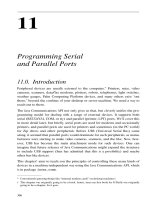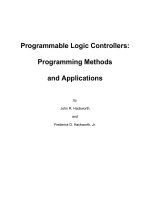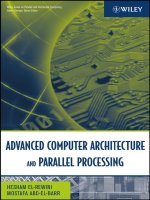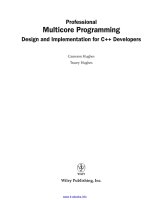Programming Serial and Parallel Ports
Bạn đang xem bản rút gọn của tài liệu. Xem và tải ngay bản đầy đủ của tài liệu tại đây (298.48 KB, 32 trang )
306
Book Title, eMatter Edition
Copyright © 2001 O’Reilly & Associates, Inc. All rights reserved.
Chapter 11
11
Programming Serial
and Parallel Ports
11:
11.0. Introduction
Peripheral devices are usually external to the computer.
*
Printers, mice, video
cameras, scanners, data/fax modems, plotters, robots, telephones, light switches,
weather gauges, Palm Computing Platform devices, and many others exist “out
there,” beyond the confines of your desktop or server machine. We need a way to
reach out to them.
The Java Communications API not only gives us that, but cleverly unifies the pro-
gramming model for dealing with a range of external devices. It supports both
serial (RS232/434, COM, or tty) and parallel (printer, LPT) ports. We’ll cover this
in more detail later, but briefly, serial ports are used for modems and occasionally
printers, and parallel ports are used for printers and sometimes (in the PC world)
for Zip drives and other peripherals. Before USB (Universal Serial Bus) came
along, it seemed that parallel ports would dominate for such peripherals, as manu-
facturers were starting to make video cameras, scanners, and the like. Now, how-
ever, USB has become the main attachment mode for such devices. One can
imagine that future releases of Java Communications might expand the structure
to include USB support (Sun has admitted that this is a possibility) and maybe
other bus-like devices.
This chapter
†
aims to teach you the principles of controlling these many kinds of
devices in a machine-independent way using the Java Communications API, which
is in package javax.comm.
* Conveniently ignoring things like “internal modem cards” on desktop machines!
† This chapter was originally going to be a book. Ironic, since my first book for O’Reilly was originally
going to be a chapter. So it goes.
,ch11.21375 Page 306 Tuesday, June 12, 2001 9:49 AM
11.0. I
NTRODUCTION
307
Book Title, eMatter Edition
Copyright © 2001 O’Reilly & Associates, Inc. All rights reserved.
I’ll start this chapter by showing you how to get a list of available ports and how to
control simple serial devices like modems. Such details as baud rate, parity, and
word size are attended to before we can write commands to the modem, read the
results, and establish communications. We’ll move on to parallel (printer) ports,
and then look at how to transfer data synchronously (using read/write calls
directly) and asynchronously (using Java listeners). Then we build a simple phone
dialer that can call a friend’s voice phone for you—a simple phone controller, if
you will. The discussion ends with a serial-port printer/plotter driver.
The Communications API
The Communications API is centered around the abstract class CommPort and its
two subclasses, SerialPort and ParallelPort, which describe the two main
types of ports found on desktop computers. CommPort represents a general model
of communications, and has general methods like getInputStream() and
getOutputStream() that allow you to use the information from Chapter 9 to
communicate with the device on that port.
However, the constructors for these classes are intentionally non-public. Rather
than constructing them, you instead use the static factory method
CommPortIdentifier.getPortIdentifiers() to get a list of ports, let the user
choose a port from this list, and call this CommPortIdentifier’s open() method
to receive a CommPort object. You cast the CommPort object to a non-abstract sub-
class representing a particular communications device. At present, the subclass
must be either SerialPort or ParallelPort.
Each of these subclasses has some methods that apply only to that type. For exam-
ple, the SerialPort class has a method to set baud rate, parity, and the like, while
the ParallelPort class has methods for setting the “port mode” to original PC
mode, bidirectional mode, etc.
Both subclasses also have methods that allow you to use the standard Java event
model to receive notification of events such as data available for reading, output
buffer empty, and type-specific events such as ring indicator for a serial port and
out-of-paper for a parallel port—as we’ll see, the parallel ports were originally for
printers, and still use their terminology in a few places.
About the Code Examples in This Chapter
Java Communication is a standard extension. This means that it is not a required
part of the Java API, which in turn means that your vendor probably didn’t ship it.
You may need to download the Java Communications API from Sun’s Java web site,
, or from your system vendor’s web site, and install it. If your
platform or vendor doesn’t ship it, you may need to find, modify, compile, and
,ch11.21375 Page 307 Tuesday, June 12, 2001 9:49 AM
308 C
HAPTER
11: P
ROGRAMMING
S
ERIAL AND
P
ARALLEL
P
ORTS
Book Title, eMatter Edition
Copyright © 2001 O’Reilly & Associates, Inc. All rights reserved.
install some C code. Try my personal web site, too. And, naturally enough, to run
some of the examples you will need additional peripheral devices beyond those
normally provided with a desktop computer. Batteries—and peripheral devices—
are not included in the purchase of this book.
See Also
Elliotte Rusty Harold’s book Java I/O contains a chapter that discusses the Com-
munications API in considerable detail, as well as some background issues such as
baud rate that we take for granted here. Rusty also discusses some details that I
have glossed over, such as the ability to set receive timeouts and buffer sizes.
This book is about portable Java. If you want the gory low-level details of setting
device registers on a 16451 UART on an ISA or PCI PC, you’ll have to look else-
where; there are several books on these topics. If you really need the hardware
details for I/O ports on other platforms such as Sun Workstations and Palm Com-
puting Platform, consult either the vendor’s documentation and/or the available
open source operating systems that run on that platform.
11.1. Choosing a Port
Problem
You need to know what ports are available on a given computer.
Solution
Use CommPortIdentifier.getPortIdentifiers() to return the list of ports.
Discussion
There are many kinds of computers out there. It’s unlikely that you’d find yourself
running on a desktop computer with no serial ports, but you might find that there
is only one and it’s already in use by another program. Or you might want a paral-
lel port and find that the computer has only serial ports. This program shows you
how to use the static CommPortIdentifier method getPortIdentifiers().
This gives you an Enumeration (Recipe 7.4) of the serial and parallel ports avail-
able on your system. My routine populate() processes this list and loads it into a
pair of JComboBoxes (graphical choosers; see Recipe 13.1), one for serial ports and
one for parallel (there is also a third, unknown, to cover future expansion of the
API). The routine makeGUI creates the JComboBoxes and arranges to notify us
when the user picks one from either of the lists. The name of the selected port is
displayed at the bottom of the window. So that you won’t have to know much about
,ch11.21375 Page 308 Tuesday, June 12, 2001 9:49 AM
11.1. C
HOOSING A
P
ORT
309
Book Title, eMatter Edition
Copyright © 2001 O’Reilly & Associates, Inc. All rights reserved.
it to use it, there are public methods getSelectedName( ), which returns the name
of the last port chosen by either JComboBox and getSelectedIdentifier(),
which returns an object called a CommPortIdentifier corresponding to the
selected port name. Figure 11-1 shows the port chooser in action.
Example 11-1 shows the code.
Figure 11-1. The Communications Port Chooser in action
Example 11-1. PortChooser.java
import java.io.*;
import javax.comm.*;
import java.awt.*;
import java.awt.event.*;
import javax.swing.*;
import java.util.*;
/**
* Choose a port, any port!
*
* Java Communications is a "standard extension" and must be downloaded
* and installed separately from the JDK before you can even compile this
* program.
*
*/
public class PortChooser extends JDialog implements ItemListener {
/** A mapping from names to CommPortIdentifiers. */
protected HashMap map = new HashMap();
/** The name of the choice the user made. */
protected String selectedPortName;
/** The CommPortIdentifier the user chose. */
protected CommPortIdentifier selectedPortIdentifier;
/** The JComboBox for serial ports */
protected JComboBox serialPortsChoice;
/** The JComboBox for parallel ports */
protected JComboBox parallelPortsChoice;
/** The JComboBox for anything else */
,ch11.21375 Page 309 Tuesday, June 12, 2001 9:49 AM
310 C
HAPTER
11: P
ROGRAMMING
S
ERIAL AND
P
ARALLEL
P
ORTS
Book Title, eMatter Edition
Copyright © 2001 O’Reilly & Associates, Inc. All rights reserved.
protected JComboBox other;
/** The SerialPort object */
protected SerialPort ttya;
/** To display the chosen */
protected JLabel choice;
/** Padding in the GUI */
protected final int PAD = 5;
/** This will be called from either of the JComboBoxes when the
* user selects any given item.
*/
public void itemStateChanged(ItemEvent e) {
// Get the name
selectedPortName = (String)((JComboBox)e.getSource()).getSelectedItem();
// Get the given CommPortIdentifier
selectedPortIdentifier = (CommPortIdentifier)map.get(selectedPortName);
// Display the name.
choice.setText(selectedPortName);
}
/* The public "getter" to retrieve the chosen port by name. */
public String getSelectedName() {
return selectedPortName;
}
/* The public "getter" to retrieve the selection by CommPortIdentifier. */
public CommPortIdentifier getSelectedIdentifier() {
return selectedPortIdentifier;
}
/** A test program to show up this chooser. */
public static void main(String[] ap) {
PortChooser c = new PortChooser(null);
c.setVisible(true);// blocking wait
System.out.println("You chose " + c.getSelectedName() +
" (known by " + c.getSelectedIdentifier() + ").");
System.exit(0);
}
/** Construct a PortChooser --make the GUI and populate the ComboBoxes.
*/
public PortChooser(JFrame parent) {
super(parent, "Port Chooser", true);
makeGUI();
populate();
finishGUI();
}
Example 11-1. PortChooser.java (continued)
,ch11.21375 Page 310 Tuesday, June 12, 2001 9:49 AM
11.1. C
HOOSING A
P
ORT
311
Book Title, eMatter Edition
Copyright © 2001 O’Reilly & Associates, Inc. All rights reserved.
/** Build the GUI. You can ignore this for now if you have not
* yet worked through the GUI chapter. Your mileage may vary.
*/
protected void makeGUI() {
Container cp = getContentPane();
JPanel centerPanel = new JPanel();
cp.add(BorderLayout.CENTER, centerPanel);
centerPanel.setLayout(new GridLayout(0,2, PAD, PAD));
centerPanel.add(new JLabel("Serial Ports", JLabel.RIGHT));
serialPortsChoice = new JComboBox();
centerPanel.add(serialPortsChoice);
serialPortsChoice.setEnabled(false);
centerPanel.add(new JLabel("Parallel Ports", JLabel.RIGHT));
parallelPortsChoice = new JComboBox();
centerPanel.add(parallelPortsChoice);
parallelPortsChoice.setEnabled(false);
centerPanel.add(new JLabel("Unknown Ports", JLabel.RIGHT));
other = new JComboBox();
centerPanel.add(other);
other.setEnabled(false);
centerPanel.add(new JLabel("Your choice:", JLabel.RIGHT));
centerPanel.add(choice = new JLabel());
JButton okButton;
cp.add(BorderLayout.SOUTH, okButton = new JButton("OK"));
okButton.addActionListener(new ActionListener() {
public void actionPerformed(ActionEvent e) {
PortChooser.this.dispose();
}
});
}
/** Populate the ComboBoxes by asking the Java Communications API
* what ports it has. Since the initial information comes from
* a Properties file, it may not exactly reflect your hardware.
*/
protected void populate() {
// get list of ports available on this particular computer,
// by calling static method in CommPortIdentifier.
Enumeration pList = CommPortIdentifier.getPortIdentifiers();
Example 11-1. PortChooser.java (continued)
,ch11.21375 Page 311 Tuesday, June 12, 2001 9:49 AM
312 C
HAPTER
11: P
ROGRAMMING
S
ERIAL AND
P
ARALLEL
P
ORTS
Book Title, eMatter Edition
Copyright © 2001 O’Reilly & Associates, Inc. All rights reserved.
11.2. Opening a Serial Port
Problem
You want to set up a serial port and open it for input/output.
Solution
Use a CommPortIdentifier’s open() method to get a SerialPort object.
Discussion
Now you’ve picked your serial port, but it’s not ready to go yet. Baud rate. Parity.
Stop bits. These things have been the bane of many a programmer’s life. Having
needed to work out the details of setting them on many platforms over the years,
including CP/M systems, IBM PCs, and IBM System/370 mainframes, I can report
// Process the list, putting serial and parallel into ComboBoxes
while (pList.hasMoreElements()) {
CommPortIdentifier cpi = (CommPortIdentifier)pList.nextElement();
// System.out.println("Port " + cpi.getName());
map.put(cpi.getName(), cpi);
if (cpi.getPortType() == CommPortIdentifier.PORT_SERIAL) {
serialPortsChoice.setEnabled(true);
serialPortsChoice.addItem(cpi.getName());
} else if (cpi.getPortType() == CommPortIdentifier.PORT_PARALLEL) {
parallelPortsChoice.setEnabled(true);
parallelPortsChoice.addItem(cpi.getName());
} else {
other.setEnabled(true);
other.addItem(cpi.getName());
}
}
serialPortsChoice.setSelectedIndex(-1);
parallelPortsChoice.setSelectedIndex(-1);
}
protected void finishGUI() {
serialPortsChoice.addItemListener(this);
parallelPortsChoice.addItemListener(this);
other.addItemListener(this);
pack();
addWindowListener(new WindowCloser(this, true));
}
}
Example 11-1. PortChooser.java (continued)
,ch11.21375 Page 312 Tuesday, June 12, 2001 9:49 AM
11.2. O
PENING A
S
ERIAL
P
ORT
313
Book Title, eMatter Edition
Copyright © 2001 O’Reilly & Associates, Inc. All rights reserved.
that it’s no fun. Finally, Java has provided a portable interface for setting all these
parameters.
The steps in setting up and opening a serial port are as follows:
1. Get the name and CommPortIdentifier (which you can do using my
PortChooser class).
2. Call the CommPortIdentifier’s open() method; cast the resulting CommPort
object to a SerialPort object (this cast will fail if the user chose a parallel
port!).
3. Set the serial communications parameters, such as baud rate, parity, stop bits,
and the like, either individually or all at once using the convenience routing
setSerialPortParams().
4. Call the getInputStream and getOutputStream methods of the
SerialPort object, and construct any additional Stream or Writer objects
(see Chapter 9).
You are then ready to read and write on the serial port. Example 11-2 is code that
implements all these steps for a serial port. Some of this code is for parallel ports,
which we’ll discuss in Recipe 11.3.
Example 11-2. CommPortOpen.java
import java.awt.*;
import java.io.*;
import javax.comm.*;
import java.util.*;
/**
* Open a serial port using Java Communications.
*
*/
public class CommPortOpen {
/** How long to wait for the open to finish up. */
public static final int TIMEOUTSECONDS = 30;
/** The baud rate to use. */
public static final int BAUD = 9600;
/** The parent Frame, for the chooser. */
protected Frame parent;
/** The input stream */
protected DataInputStream is;
/** The output stream */
protected PrintStream os;
/** The last line read from the serial port. */
protected String response;
/** A flag to control debugging output. */
protected boolean debug = true;
,ch11.21375 Page 313 Tuesday, June 12, 2001 9:49 AM
314 C
HAPTER
11: P
ROGRAMMING
S
ERIAL AND
P
ARALLEL
P
ORTS
Book Title, eMatter Edition
Copyright © 2001 O’Reilly & Associates, Inc. All rights reserved.
/** The chosen Port Identifier */
CommPortIdentifier thePortID;
/** The chosen Port itself */
CommPort thePort;
public static void main(String[] argv)
throws IOException, NoSuchPortException, PortInUseException,
UnsupportedCommOperationException {
new CommPortOpen(null).converse();
System.exit(0);
}
/* Constructor */
public CommPortOpen(Frame f)
throws IOException, NoSuchPortException, PortInUseException,
UnsupportedCommOperationException {
// Use the PortChooser from before. Pop up the JDialog.
PortChooser chooser = new PortChooser(null);
String portName = null;
do {
chooser.setVisible(true);
// Dialog done. Get the port name.
portName = chooser.getSelectedName();
if (portName == null)
System.out.println("No port selected. Try again.\n");
} while (portName == null);
// Get the CommPortIdentifier.
thePortID = chooser.getSelectedIdentifier();
// Now actually open the port.
// This form of openPort takes an Application Name and a timeout.
//
System.out.println("Trying to open " + thePortID.getName() + "...");
switch (thePortID.getPortType()) {
case CommPortIdentifier.PORT_SERIAL:
thePort = thePortID.open("DarwinSys DataComm",
TIMEOUTSECONDS * 1000);
SerialPort myPort = (SerialPort) thePort;
Example 11-2. CommPortOpen.java (continued)
,ch11.21375 Page 314 Tuesday, June 12, 2001 9:49 AM
11.2. O
PENING A
S
ERIAL
P
ORT
315
Book Title, eMatter Edition
Copyright © 2001 O’Reilly & Associates, Inc. All rights reserved.
// set up the serial port
myPort.setSerialPortParams(BAUD, SerialPort.DATABITS_8,
SerialPort.STOPBITS_1, SerialPort.PARITY_NONE);
break;
case CommPortIdentifier.PORT_PARALLEL:
thePort = thePortID.open("DarwinSys Printing",
TIMEOUTSECONDS * 1000);
ParallelPort pPort = (ParallelPort)thePort;
// Tell API to pick "best available mode" - can fail!
// myPort.setMode(ParallelPort.LPT_MODE_ANY);
// Print what the mode is
int mode = pPort.getMode();
switch (mode) {
case ParallelPort.LPT_MODE_ECP:
System.out.println("Mode is: ECP");
break;
case ParallelPort.LPT_MODE_EPP:
System.out.println("Mode is: EPP");
break;
case ParallelPort.LPT_MODE_NIBBLE:
System.out.println("Mode is: Nibble Mode.");
break;
case ParallelPort.LPT_MODE_PS2:
System.out.println("Mode is: Byte mode.");
break;
case ParallelPort.LPT_MODE_SPP:
System.out.println("Mode is: Compatibility mode.");
break;
// ParallelPort.LPT_MODE_ANY is a "set only" mode;
// tells the API to pick "best mode"; will report the
// actual mode it selected.
default:
throw new IllegalStateException
("Parallel mode " + mode + " invalid.");
}
break;
default:// Neither parallel nor serial??
throw new IllegalStateException("Unknown port type " + thePortID);
}
// Get the input and output streams
// Printers can be write-only
try {
is = new DataInputStream(thePort.getInputStream());
Example 11-2. CommPortOpen.java (continued)
,ch11.21375 Page 315 Tuesday, June 12, 2001 9:49 AM
316 C
HAPTER
11: P
ROGRAMMING
S
ERIAL AND
P
ARALLEL
P
ORTS
Book Title, eMatter Edition
Copyright © 2001 O’Reilly & Associates, Inc. All rights reserved.
As noted in the comments, this class contains a dummy version of the converse
method. In following sections we’ll expand on the input/output processing by
subclassing and overriding this method.
11.3. Opening a Parallel Port
Problem
You want to open a parallel port.
Solution
Use a CommPortIdentifier’s open() method to get a ParallelPort object.
Discussion
Enough of serial ports! Parallel ports as we know ’em are an outgrowth of the “dot
matrix” printer industry. Before the IBM PC, Tandy and other “pre-PC” PC mak-
ers needed a way to hook printers to their computers. Centronics, a company that
made a variety of dot matrix printers, had a standard connector mechanism that
caught on, changing only when IBM got into the act. Along the way, PC makers
} catch (IOException e) {
System.err.println("Can't open input stream: write-only");
is = null;
}
os = new PrintStream(thePort.getOutputStream(), true);
}
/** This method will be overridden by non-trivial subclasses
* to hold a conversation.
*/
protected void converse() throws IOException {
System.out.println("Ready to read and write port.");
// Input/Output code not written -- must subclass.
// Finally, clean up.
if (is != null)
is.close();
os.close();
}
}
Example 11-2. CommPortOpen.java (continued)
,ch11.21375 Page 316 Tuesday, June 12, 2001 9:49 AM
11.3. O
PENING A
P
ARALLEL
P
ORT
317
Book Title, eMatter Edition
Copyright © 2001 O’Reilly & Associates, Inc. All rights reserved.
found they needed more speed, so they built faster printer ports. And peripheral
makers took advantage of this by using the faster (and by now bidirectional)
printer ports to hook up all manner of weird devices like scanners, SCSI and
Ethernet controllers, and others via parallel ports. You can, in theory, open any of
these devices and control them; the logic of controlling such devices is left as an
exercise for the reader. For now we’ll just open a parallel port.
Just as the SerialPortOpen program set the port’s parameters, the
ParallelPortOpen program sets the parallel port access type or “mode.” Like
baud rate and parity, this requires some knowledge of the particular desktop com-
puter’s hardware. There are several common modes, or types of printer interface
and interaction. The oldest is “simple parallel port,” which the API calls MODE_
SPP. This is an output-only parallel port. Other common modes include EPP
(extended parallel port, MODE_ECP) and ECP (extended communciation port,
MODE_ECP). The API defines a few rare ones, as well as MODE_ANY, the default,
and allows the API to pick the best mode. In my experience, the API doesn’t
always do a very good job of picking, either with MODE_ANY or with explicit set-
tings. And indeed, there may be interactions with the BIOS (at least on a PC) and
on device drivers (MS-Windows, Unix). What follows is a simple example that
opens a parallel port (though it works on a serial port also), opens a file, and
sends it; in other words, a very trivial printer driver. Now this is obviously not the
way to drive printers. Most operating systems provide support for various types of
printers (the MacOS and MS-Windows both do, at least; Unix tends to assume a
PostScript or HP printer). This example, just to make life simple by allowing us to
work with ASCII files, copies a short file of PostScript. The intent of the PostScript
job is just to print the little logo in Figure 11-2.
The PostScript code used in this particular example is fairly short:
%!PS-Adobe
% Draw a circle of "Java Cookbook"
% simplified from Chapter 9 of the Adobe Systems "Blue Book",
% PostScript Language Tutorial and Cookbook
Figure 11-2. PostScript printer output
,ch11.21375 Page 317 Tuesday, June 12, 2001 9:49 AM









